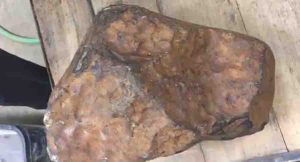
UND welcomed an alien invader Friday.
The 84-pound space monster was on campus for just a few hours, but it left behind a small slice of history.
“Colgate” came to campus with Alexander Erickson, a computer science junior from Colgate, N.D.
It’s Colgate’s second visit to UND. Erickson’s father, who found it while moving boulders to build a new home, brought it to Nels Forsman, assistant professor in the Harold Hamm School of Geology and Geological Engineering. Forsman identified it as a meteorite in 1999.
It’s the largest meteorite ever found in North Dakota, said Forsman. He added that meteorites are named for the location near where they are found, and this one has been dubbed “Colgate.”
Erickson brought the rock in for a second visit so students and scientists could slice a sample and study it.
“My dad always wanted to get it classified and in the books,” said Erickson, whose father has since passed away. “I wanted to make sure this was done.”
Erickson said he and his family will keep Colgate as a family heirloom.
“I grew up with it,” he said. “It was always around. Not a lot of people can say they have a meteorite.”
Colgate is estimated to be about 4.6 billion years old – as old as Earth and more ancient than any rock on this planet. It’s part of an asteroid that broke up on entering Earth’s atmosphere.
Justin Germann, a geology senior from Bowman, N.D., and Forsman used a specialized saw to slice a piece of the rock for further study.
“It was incredible to see the inside of the rock,” said Erickson, who watched as Forsman and Germann took the sample.
“You can see the fractures from when it entered the atmosphere,” Germann said, pointing to the rock, which is dark charcoal with indentations.
Forsman said that asteroids start to vaporize upon entry, forming a fusion crust with dimples. The interior of the rock has bits of nickel-iron that “sparkle.”
It’s a chondrite, one of the more common types of meteorites. “That means it has circular minerals, which are only found in meteorites,” said Germann.
Germann will work with the section using an electron microprobe, and will cut very thin sections of the sample to identify minerals in the rock. It will be the basis of his senior thesis.
Forsman and Germann will work separately when classifying the section to ensure their findings are correct.
And they will examine it to see if they can discover new information about how the solar system was formed.
“It’s fascinating. You can get new and surprising information when you look at meteorites,” said Forsman. who wrote Meteorites in North Dakota with co-author Ed Murphy, now head of the North Dakota Geological Survey in Bismarck. He plans to add this meteorite to the next edition of the book.
Note: The above post is reprinted from materials provided by University of North Dakota.









